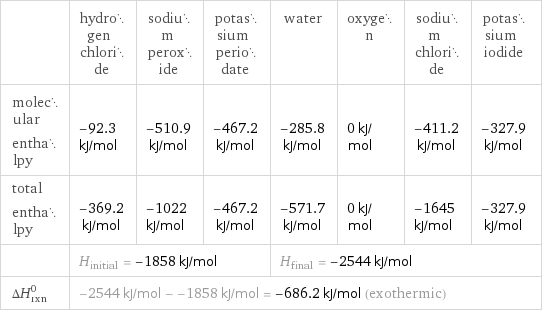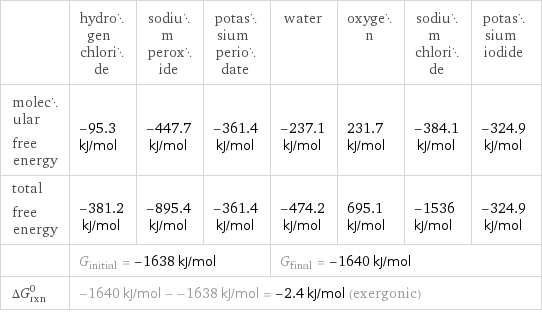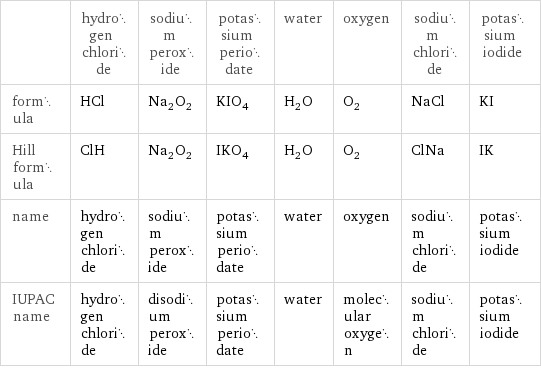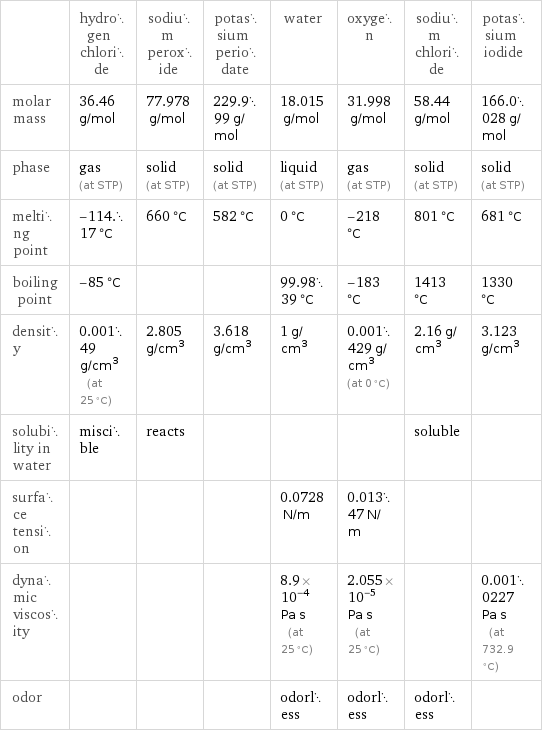Input interpretation

HCl hydrogen chloride + Na_2O_2 sodium peroxide + KIO_4 potassium periodate ⟶ H_2O water + O_2 oxygen + NaCl sodium chloride + KI potassium iodide
Balanced equation

Balance the chemical equation algebraically: HCl + Na_2O_2 + KIO_4 ⟶ H_2O + O_2 + NaCl + KI Add stoichiometric coefficients, c_i, to the reactants and products: c_1 HCl + c_2 Na_2O_2 + c_3 KIO_4 ⟶ c_4 H_2O + c_5 O_2 + c_6 NaCl + c_7 KI Set the number of atoms in the reactants equal to the number of atoms in the products for Cl, H, Na, O, I and K: Cl: | c_1 = c_6 H: | c_1 = 2 c_4 Na: | 2 c_2 = c_6 O: | 2 c_2 + 4 c_3 = c_4 + 2 c_5 I: | c_3 = c_7 K: | c_3 = c_7 Since the coefficients are relative quantities and underdetermined, choose a coefficient to set arbitrarily. To keep the coefficients small, the arbitrary value is ordinarily one. For instance, set c_3 = 1 and solve the system of equations for the remaining coefficients: c_2 = c_1/2 c_3 = 1 c_4 = c_1/2 c_5 = c_1/4 + 2 c_6 = c_1 c_7 = 1 The resulting system of equations is still underdetermined, so an additional coefficient must be set arbitrarily. Set c_1 = 4 and solve for the remaining coefficients: c_1 = 4 c_2 = 2 c_3 = 1 c_4 = 2 c_5 = 3 c_6 = 4 c_7 = 1 Substitute the coefficients into the chemical reaction to obtain the balanced equation: Answer: | | 4 HCl + 2 Na_2O_2 + KIO_4 ⟶ 2 H_2O + 3 O_2 + 4 NaCl + KI
Structures

+ + ⟶ + + +
Names

hydrogen chloride + sodium peroxide + potassium periodate ⟶ water + oxygen + sodium chloride + potassium iodide
Reaction thermodynamics
Enthalpy

| hydrogen chloride | sodium peroxide | potassium periodate | water | oxygen | sodium chloride | potassium iodide molecular enthalpy | -92.3 kJ/mol | -510.9 kJ/mol | -467.2 kJ/mol | -285.8 kJ/mol | 0 kJ/mol | -411.2 kJ/mol | -327.9 kJ/mol total enthalpy | -369.2 kJ/mol | -1022 kJ/mol | -467.2 kJ/mol | -571.7 kJ/mol | 0 kJ/mol | -1645 kJ/mol | -327.9 kJ/mol | H_initial = -1858 kJ/mol | | | H_final = -2544 kJ/mol | | | ΔH_rxn^0 | -2544 kJ/mol - -1858 kJ/mol = -686.2 kJ/mol (exothermic) | | | | | |
Gibbs free energy

| hydrogen chloride | sodium peroxide | potassium periodate | water | oxygen | sodium chloride | potassium iodide molecular free energy | -95.3 kJ/mol | -447.7 kJ/mol | -361.4 kJ/mol | -237.1 kJ/mol | 231.7 kJ/mol | -384.1 kJ/mol | -324.9 kJ/mol total free energy | -381.2 kJ/mol | -895.4 kJ/mol | -361.4 kJ/mol | -474.2 kJ/mol | 695.1 kJ/mol | -1536 kJ/mol | -324.9 kJ/mol | G_initial = -1638 kJ/mol | | | G_final = -1640 kJ/mol | | | ΔG_rxn^0 | -1640 kJ/mol - -1638 kJ/mol = -2.4 kJ/mol (exergonic) | | | | | |
Equilibrium constant
![Construct the equilibrium constant, K, expression for: HCl + Na_2O_2 + KIO_4 ⟶ H_2O + O_2 + NaCl + KI Plan: • Balance the chemical equation. • Determine the stoichiometric numbers. • Assemble the activity expression for each chemical species. • Use the activity expressions to build the equilibrium constant expression. Write the balanced chemical equation: 4 HCl + 2 Na_2O_2 + KIO_4 ⟶ 2 H_2O + 3 O_2 + 4 NaCl + KI Assign stoichiometric numbers, ν_i, using the stoichiometric coefficients, c_i, from the balanced chemical equation in the following manner: ν_i = -c_i for reactants and ν_i = c_i for products: chemical species | c_i | ν_i HCl | 4 | -4 Na_2O_2 | 2 | -2 KIO_4 | 1 | -1 H_2O | 2 | 2 O_2 | 3 | 3 NaCl | 4 | 4 KI | 1 | 1 Assemble the activity expressions accounting for the state of matter and ν_i: chemical species | c_i | ν_i | activity expression HCl | 4 | -4 | ([HCl])^(-4) Na_2O_2 | 2 | -2 | ([Na2O2])^(-2) KIO_4 | 1 | -1 | ([KIO4])^(-1) H_2O | 2 | 2 | ([H2O])^2 O_2 | 3 | 3 | ([O2])^3 NaCl | 4 | 4 | ([NaCl])^4 KI | 1 | 1 | [KI] The equilibrium constant symbol in the concentration basis is: K_c Mulitply the activity expressions to arrive at the K_c expression: Answer: | | K_c = ([HCl])^(-4) ([Na2O2])^(-2) ([KIO4])^(-1) ([H2O])^2 ([O2])^3 ([NaCl])^4 [KI] = (([H2O])^2 ([O2])^3 ([NaCl])^4 [KI])/(([HCl])^4 ([Na2O2])^2 [KIO4])](../image_source/45aa81d661055dba9e029b5bdad05493.png)
Construct the equilibrium constant, K, expression for: HCl + Na_2O_2 + KIO_4 ⟶ H_2O + O_2 + NaCl + KI Plan: • Balance the chemical equation. • Determine the stoichiometric numbers. • Assemble the activity expression for each chemical species. • Use the activity expressions to build the equilibrium constant expression. Write the balanced chemical equation: 4 HCl + 2 Na_2O_2 + KIO_4 ⟶ 2 H_2O + 3 O_2 + 4 NaCl + KI Assign stoichiometric numbers, ν_i, using the stoichiometric coefficients, c_i, from the balanced chemical equation in the following manner: ν_i = -c_i for reactants and ν_i = c_i for products: chemical species | c_i | ν_i HCl | 4 | -4 Na_2O_2 | 2 | -2 KIO_4 | 1 | -1 H_2O | 2 | 2 O_2 | 3 | 3 NaCl | 4 | 4 KI | 1 | 1 Assemble the activity expressions accounting for the state of matter and ν_i: chemical species | c_i | ν_i | activity expression HCl | 4 | -4 | ([HCl])^(-4) Na_2O_2 | 2 | -2 | ([Na2O2])^(-2) KIO_4 | 1 | -1 | ([KIO4])^(-1) H_2O | 2 | 2 | ([H2O])^2 O_2 | 3 | 3 | ([O2])^3 NaCl | 4 | 4 | ([NaCl])^4 KI | 1 | 1 | [KI] The equilibrium constant symbol in the concentration basis is: K_c Mulitply the activity expressions to arrive at the K_c expression: Answer: | | K_c = ([HCl])^(-4) ([Na2O2])^(-2) ([KIO4])^(-1) ([H2O])^2 ([O2])^3 ([NaCl])^4 [KI] = (([H2O])^2 ([O2])^3 ([NaCl])^4 [KI])/(([HCl])^4 ([Na2O2])^2 [KIO4])
Rate of reaction
![Construct the rate of reaction expression for: HCl + Na_2O_2 + KIO_4 ⟶ H_2O + O_2 + NaCl + KI Plan: • Balance the chemical equation. • Determine the stoichiometric numbers. • Assemble the rate term for each chemical species. • Write the rate of reaction expression. Write the balanced chemical equation: 4 HCl + 2 Na_2O_2 + KIO_4 ⟶ 2 H_2O + 3 O_2 + 4 NaCl + KI Assign stoichiometric numbers, ν_i, using the stoichiometric coefficients, c_i, from the balanced chemical equation in the following manner: ν_i = -c_i for reactants and ν_i = c_i for products: chemical species | c_i | ν_i HCl | 4 | -4 Na_2O_2 | 2 | -2 KIO_4 | 1 | -1 H_2O | 2 | 2 O_2 | 3 | 3 NaCl | 4 | 4 KI | 1 | 1 The rate term for each chemical species, B_i, is 1/ν_i(Δ[B_i])/(Δt) where [B_i] is the amount concentration and t is time: chemical species | c_i | ν_i | rate term HCl | 4 | -4 | -1/4 (Δ[HCl])/(Δt) Na_2O_2 | 2 | -2 | -1/2 (Δ[Na2O2])/(Δt) KIO_4 | 1 | -1 | -(Δ[KIO4])/(Δt) H_2O | 2 | 2 | 1/2 (Δ[H2O])/(Δt) O_2 | 3 | 3 | 1/3 (Δ[O2])/(Δt) NaCl | 4 | 4 | 1/4 (Δ[NaCl])/(Δt) KI | 1 | 1 | (Δ[KI])/(Δt) (for infinitesimal rate of change, replace Δ with d) Set the rate terms equal to each other to arrive at the rate expression: Answer: | | rate = -1/4 (Δ[HCl])/(Δt) = -1/2 (Δ[Na2O2])/(Δt) = -(Δ[KIO4])/(Δt) = 1/2 (Δ[H2O])/(Δt) = 1/3 (Δ[O2])/(Δt) = 1/4 (Δ[NaCl])/(Δt) = (Δ[KI])/(Δt) (assuming constant volume and no accumulation of intermediates or side products)](../image_source/01eef684e8f284101e816562f60e6b12.png)
Construct the rate of reaction expression for: HCl + Na_2O_2 + KIO_4 ⟶ H_2O + O_2 + NaCl + KI Plan: • Balance the chemical equation. • Determine the stoichiometric numbers. • Assemble the rate term for each chemical species. • Write the rate of reaction expression. Write the balanced chemical equation: 4 HCl + 2 Na_2O_2 + KIO_4 ⟶ 2 H_2O + 3 O_2 + 4 NaCl + KI Assign stoichiometric numbers, ν_i, using the stoichiometric coefficients, c_i, from the balanced chemical equation in the following manner: ν_i = -c_i for reactants and ν_i = c_i for products: chemical species | c_i | ν_i HCl | 4 | -4 Na_2O_2 | 2 | -2 KIO_4 | 1 | -1 H_2O | 2 | 2 O_2 | 3 | 3 NaCl | 4 | 4 KI | 1 | 1 The rate term for each chemical species, B_i, is 1/ν_i(Δ[B_i])/(Δt) where [B_i] is the amount concentration and t is time: chemical species | c_i | ν_i | rate term HCl | 4 | -4 | -1/4 (Δ[HCl])/(Δt) Na_2O_2 | 2 | -2 | -1/2 (Δ[Na2O2])/(Δt) KIO_4 | 1 | -1 | -(Δ[KIO4])/(Δt) H_2O | 2 | 2 | 1/2 (Δ[H2O])/(Δt) O_2 | 3 | 3 | 1/3 (Δ[O2])/(Δt) NaCl | 4 | 4 | 1/4 (Δ[NaCl])/(Δt) KI | 1 | 1 | (Δ[KI])/(Δt) (for infinitesimal rate of change, replace Δ with d) Set the rate terms equal to each other to arrive at the rate expression: Answer: | | rate = -1/4 (Δ[HCl])/(Δt) = -1/2 (Δ[Na2O2])/(Δt) = -(Δ[KIO4])/(Δt) = 1/2 (Δ[H2O])/(Δt) = 1/3 (Δ[O2])/(Δt) = 1/4 (Δ[NaCl])/(Δt) = (Δ[KI])/(Δt) (assuming constant volume and no accumulation of intermediates or side products)
Chemical names and formulas

| hydrogen chloride | sodium peroxide | potassium periodate | water | oxygen | sodium chloride | potassium iodide formula | HCl | Na_2O_2 | KIO_4 | H_2O | O_2 | NaCl | KI Hill formula | ClH | Na_2O_2 | IKO_4 | H_2O | O_2 | ClNa | IK name | hydrogen chloride | sodium peroxide | potassium periodate | water | oxygen | sodium chloride | potassium iodide IUPAC name | hydrogen chloride | disodium peroxide | potassium periodate | water | molecular oxygen | sodium chloride | potassium iodide
Substance properties

| hydrogen chloride | sodium peroxide | potassium periodate | water | oxygen | sodium chloride | potassium iodide molar mass | 36.46 g/mol | 77.978 g/mol | 229.999 g/mol | 18.015 g/mol | 31.998 g/mol | 58.44 g/mol | 166.0028 g/mol phase | gas (at STP) | solid (at STP) | solid (at STP) | liquid (at STP) | gas (at STP) | solid (at STP) | solid (at STP) melting point | -114.17 °C | 660 °C | 582 °C | 0 °C | -218 °C | 801 °C | 681 °C boiling point | -85 °C | | | 99.9839 °C | -183 °C | 1413 °C | 1330 °C density | 0.00149 g/cm^3 (at 25 °C) | 2.805 g/cm^3 | 3.618 g/cm^3 | 1 g/cm^3 | 0.001429 g/cm^3 (at 0 °C) | 2.16 g/cm^3 | 3.123 g/cm^3 solubility in water | miscible | reacts | | | | soluble | surface tension | | | | 0.0728 N/m | 0.01347 N/m | | dynamic viscosity | | | | 8.9×10^-4 Pa s (at 25 °C) | 2.055×10^-5 Pa s (at 25 °C) | | 0.0010227 Pa s (at 732.9 °C) odor | | | | odorless | odorless | odorless |
Units
